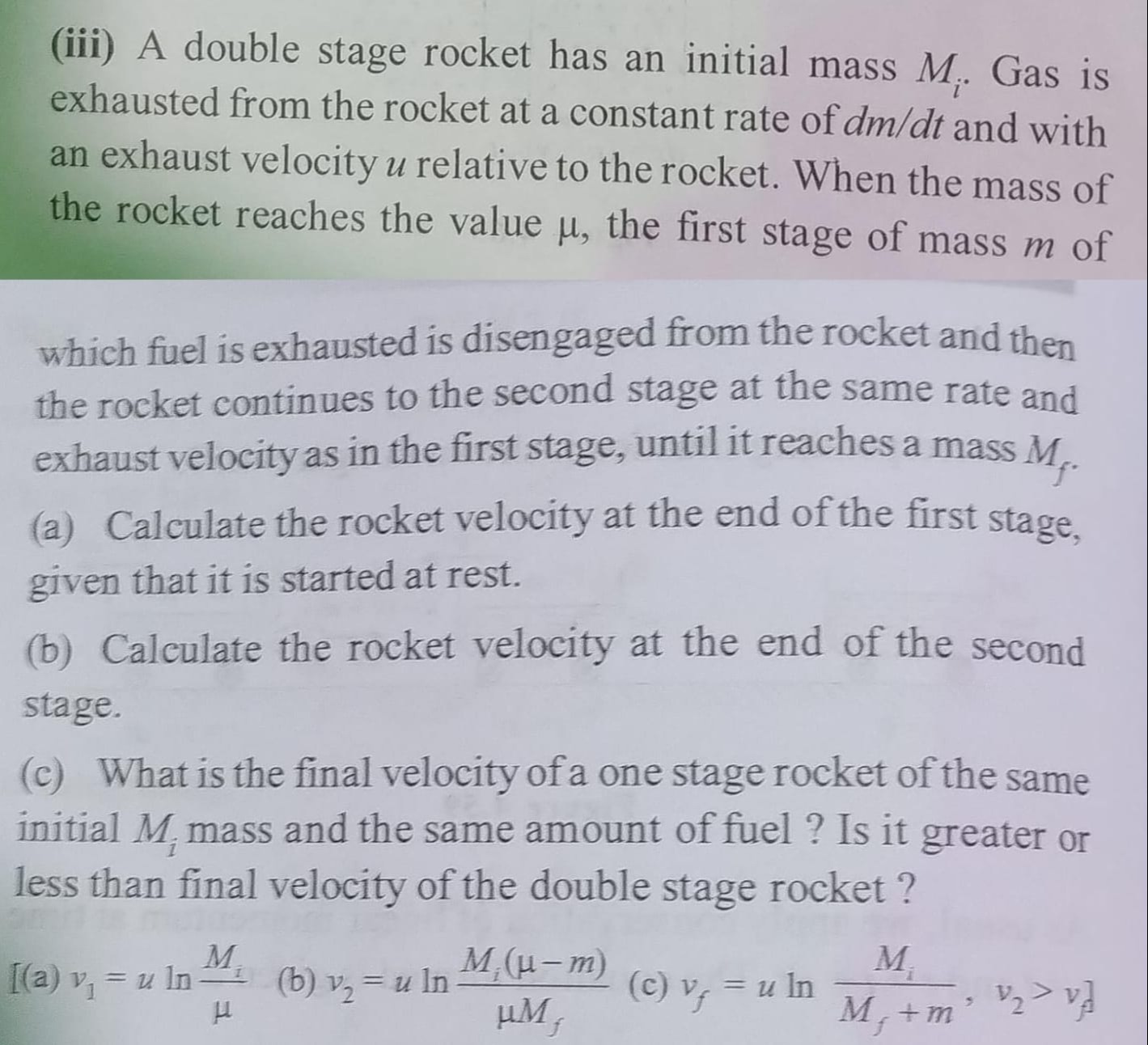Question
Question: (iii) A double stage rocket has an initial mass $M_i$. Gas is exhausted from the rocket at a constan...
(iii) A double stage rocket has an initial mass Mi. Gas is exhausted from the rocket at a constant rate of dm/dt and with an exhaust velocity u relative to the rocket. When the mass of the rocket reaches the value μ, the first stage of mass m of which fuel is exhausted is disengaged from the rocket and then the rocket continues to the second stage at the same rate and exhaust velocity as in the first stage, until it reaches a mass Mf.
(a) Calculate the rocket velocity at the end of the first stage, given that it is started at rest.
(b) Calculate the rocket velocity at the end of the second stage.
(c) What is the final velocity of a one stage rocket of the same initial Mi mass and the same amount of fuel ? Is it greater or less than final velocity of the double stage rocket ?

(a) v1=ulnμMi (b) v2=ulnμMfMi(μ−m) (c) vf=ulnMf+mMi, v2>vf
(a) v1=ulnMiμ (b) v2=ulnMi(μ−m)μMf (c) vf=ulnMiMf+m, v2<vf
(a) v1=ulnMfMi (b) v2=ulnMfMi (c) vf=ulnMfMi, v2=vf
(a) v1=ulnMiμ (b) v2=ulnμMfMi(μ−m) (c) vf=ulnMf+mMi, v2>vf
(a) v1=ulnμMi (b) v2=ulnμMfMi(μ−m) (c) vf=ulnMf+mMi, v2>vf
Solution
The problem describes a two-stage rocket and asks for velocity calculations at different stages and a comparison with a single-stage rocket. The core principle is the Tsiolkovsky rocket equation: Δv=uln(mfmi), where u is the exhaust velocity, mi is the initial mass, and mf is the final mass.
(a) Velocity at the end of the first stage: The first stage starts with mass Mi and ends with mass μ. The rocket starts from rest. Using the rocket equation: v1=uln(μMi)
(b) Velocity at the end of the second stage: The second stage starts after the first stage is disengaged. The mass at the end of stage 1 is μ. The first stage structure of mass m is then disengaged, so the mass at the start of stage 2 is (μ−m). The second stage ends with mass Mf. The velocity gained during stage 2 is: vstage2_gain=uln(Mfμ−m) The total velocity at the end of the second stage (v2) is the sum of velocities from both stages: v2=v1+vstage2_gain=uln(μMi)+uln(Mfμ−m) Using the logarithm property lnA+lnB=ln(AB): v2=uln(μMi⋅Mfμ−m)=uln(μMfMi(μ−m))
(c) Final velocity of a one-stage rocket and comparison: For a one-stage rocket with the same initial mass (Mi) and the same total amount of fuel: Total fuel in the double-stage rocket = (Mi−μ)+((μ−m)−Mf)=Mi−m−Mf. The final mass of the one-stage rocket will be: Mi−(Total fuel)=Mi−(Mi−m−Mf)=Mf+m. The final velocity of the one-stage rocket (vf) is: vf=uln(Mf+mMi)
Comparison: We need to compare v2 and vf. This is equivalent to comparing the arguments of the logarithm: Argument for v2: μMfMi(μ−m) Argument for vf: Mf+mMi We compare μMfμ−m with Mf+m1. Cross-multiplying: (μ−m)(Mf+m) vs μMf. Expanding: μMf+μm−mMf−m2 vs μMf. This simplifies to: μm−mMf−m2 vs 0. Factoring out m (since m>0): m(μ−Mf−m) vs 0. The comparison is between μ−Mf−m and 0. For the second stage to function, its initial mass must be greater than its final mass: μ−m>Mf, which implies μ>Mf+m. Therefore, μ−Mf−m>0. This means m(μ−Mf−m)>0, so (μ−m)(Mf+m)>μMf. Consequently, μMfMi(μ−m)>Mf+mMi. Since the logarithm is an increasing function, v2>vf. The final velocity of the double-stage rocket is greater than that of the single-stage rocket because the jettisoning of the first stage structure reduces the final mass more effectively, leading to a higher overall mass ratio.
Summary: (a) v1=ulnμMi (b) v2=ulnμMfMi(μ−m) (c) vf=ulnMf+mMi. The final velocity of the double-stage rocket (v2) is greater than the final velocity of the one-stage rocket (vf).
